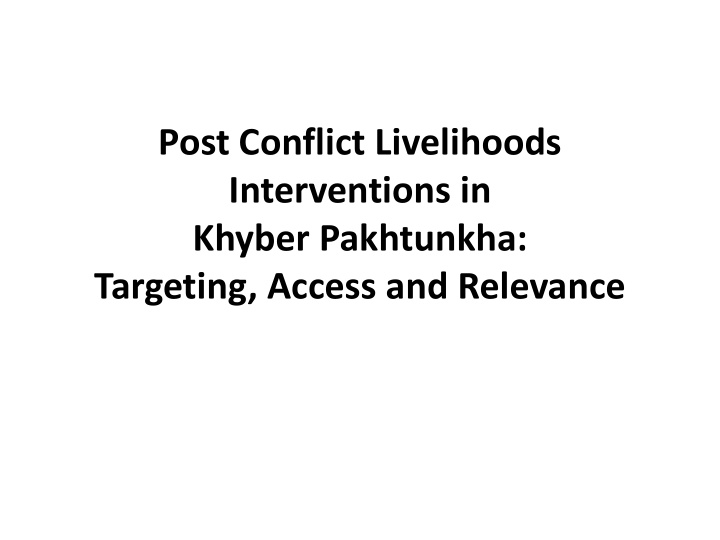



Post Conflict Livelihoods Interventions in Khyber Pakhtunkha: Targeting, Access and Relevance
Background • Due to conflict in Malakand (2007-09) around 2.50-3.00 million people were displaced • Losses were huge in terms of lives and livelihoods • Agriculture sector alone in Swat District registered loss of PKR 5 billion in one year • 69% reduction in Livestock holding in post- conflict Swat • To help affectees, Government, donors, national international NGOs and local communities joined hands together
Background • To study how conflict has affected Livelihoods in Swat and Lower Dir SDPI conducted a survey in selected union councils of District Swat ad Lower Dir with 2114 households in 2012. Sample size is representative at Union Council level however equally distributed over number of villages constituting a particular UC. The Union Councils include Haya Serai and Lal Qila from Lower Dir and Charbagh, Baidara and Bar Abakhel from Swat. 34% of the respondents were female. • Survey results shows 24% of the households from the sample has benefitted from at least one type of livelihood intervention. • Seed and tool distribution remain major intervention received by 12% of the households followed by poultry (9%) and fertilizer/pesticide (7%). Agriculture extension services were received by 1% only. • 25% of households have received cash grants of which 20% is through BISP. Zakat, Bait ul Mal, Sadqat contribution remain low.
Livelihoods Strategies • According to Preliminary Damage Need Assessment, ‘approximately 57% people are employed in agriculture, forestry and fishing followed by community, social and personal services (12.15%), construction (11.21%) and wholesale, retail trade and restaurants (9.49%). Transport, storage and communications accounted for 4.66%, whereas, manufacturing stood at 3.18%. • Agriculture is the major livelihood activity however remittances has a major share in household income. 50% of the population has no employment and illiterate with average household size is almost 9 people/hh. 34% of HH rely on single source of income, 42% rely on two and only 18% have three sources of income
Methodology • Study extensively embarks upon Qualitative data gathered through Focus Group Discussions (FGDs) and Key Informant Interviews (KIIS) • The Data collection is complemented by the Quantitative survey as well • Two UCs one from Swat (Charbagh) and Lower Dir (Haya Serai) were selected in consultation with PaRRSA, District administration, NGOs and mapping of interventions • 30 FGDs in total (10 male 5 female in each UC) • Participants of FGDs included both beneficiaries and non-beneficiaries of any intervention.
Type of Interventions • While mapping interventions it was found donors, NGOs and the Government has focused on provision of household items and food, cash grants, provision of livestock, agricultural inputs including fertilizer, seed and equipment, fruit saplings, micro-credit lending, infrastructure, sewing machines, skills development and business development trainings and food/cash for work.
Actors and Structures Involved in Service Provision for Livelihood Reconstruction • Federal and Provincial Governments, Bilateral & Multi lateral Donors, International, National & Local NGOs are the major actors. • Other than DAC, Turkey, Qatar, Saudi Arabia and UAE governments have funded various interventions • Some important structures include MDTF and PaRRSA • DNA out of USD 89million budget allocated USD 19 million for revitalization of livelihoods whereas under PCNA USD 786 million and USD 635 million were allocated for Social Protection and Agriculture & Natural Resources to revive livelihoods.
Results (Targeting) • Due to scale of emergency, most of the implementing organisations have pumped money without any proper assessment soon after the return of IDPs to their homes • Organisations which have worked in the Recovery Phase has carried out need and beneficiary assessments • PaRRSA and Military were helping Humanitarian Community in the selection of area • Many organisations were new to area and did not know local context (institutions, norms and culture) so they relied on local employees hired on short term contract or village notables to identify beneficiaries/needy • Procedural hick ups such as Computerized NIC was a challenge for women
Results (Access) • Most organised targeting and access has been reported for housing compensation and for award of cash grants • Organisations have used Mosques or Community Citizen Boards and other CBOs formed by different NGOs before conflict and that has been found effective • Farmers not landowners received seed, fertilizer and equipment • Donors went to most accessible areas and not to areas hard to reach or far flung from main cities due to security concerns • Women could not register themselves because NGO wanted to establish a committee and men did not allowed
Results (Relevance) • People agreed that providing seed and fertilizer was a good step. Provision of food immediate after return has generally been applauded. Cash generally has been regarded as most important intervention. • Scope of the interventions has been questioned! • People questioned Bio-gas plants or Swat Festival when people were asking for Water schemes • Women have generally questioned cash for work schemes • Vouchers to purchase specific items from specified shops created monopoly of the shop keepers who supplied sub-standard tools • Animals distributed in Swat and Dir were not fit for the area • Participants in FGDs time and again mentioned no one asked about their needs; every one came with a fixed package
Conclusions • Interventions were: – No proper assessment at least during Relief phase – Elite Captured or Elite Controlled – Not well connected sections of the society/areas were left out – Locked funding – Line Departments were not involved in designing interventions – Ignorance of local norms and culture – Donors, in general failed to understand local power structures and traditional institutions
It was Not Them (donors), it was Us (Focal persons) who deceived them and ourselves!
Recommend
More recommend